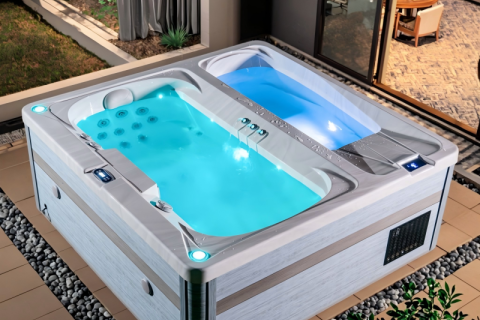
- Home
- >
News
For example, if a standard outdoor whirlpool hot tub has 10 jets, the pump power might be 1 kilowatt; if the number is increased to 20, the pump power requirement might increase to 1.5 kilowatts or more. This means that as the number of jets increases, the pump consumes more electricity to maintain normal operation.
Unsuitable Locations for Outdoor Spa Hot Tubs 1. Unreinforced natural soil 2. Unenclosed or open areas with exposed drafts 3. Directly under dripping eaves or snow 4. Areas near gas utilities, cables, or high-voltage equipment 5. Low-lying areas without a good drainage system
If using a float-type water level sensor, adjust the float position to ensure it accurately responds to water level changes. Typically, the float should be placed near the bathtub's water level to ensure it rises and falls with water level fluctuations.
Water quality significantly impacts the lifespan of a small outdoor hot tub pump. Impurities, minerals, bacteria, and other substances in the water can damage the pump during operation.
The water pump and filter are responsible for maintaining the cleanliness and hygiene of your bathtub water, ensuring it remains free of contamination during use. Using soap or other detergents in your outdoor whirlpool hot tub can negatively impact the filtration system.
Patients who are not suitable for using the whirlpool spa hot tub: 1. Patients with low blood pressure 2. Patients with heart disease 3. Patients with dizziness and nausea 4. Pregnant women 5. Patients with skin diseases and infectious diseases 6. Patients with abnormal blood sugar levels (such as diabetics) 7. Elderly people and people with limited mobility
Test data shows that most whirlpool spa hot tubs generate noise levels between 41 and 67 decibels when operating normally. This level is equivalent to a normal conversation or television playback in a room. For most people, this noise level is not noticeably disturbing.
The heater is a crucial component of an outdoor whirlpool hot tub. The higher the heater power, the faster the water heats and the shorter the use time. However, a higher-power heater typically consumes more electricity, leading to higher electricity bills.
According to product catalogs and manufacturer specifications, a standard-sized (approximately 2200mm × 2200mm × 950mm) five-person spa hot tub with mid-to-high-end features typically weighs between 230 kg and 400 kg empty. Some high-end models with thicker insulation or integrated sound systems can even weigh up to 500 kg.
Our 20 experts and 200 workers perform strict inspections at every stage of production, guaranteeing that buyers receive high quality spas at low factory prices. Unlike some suppliers that compromise quality for cheap costs, we balance both by offering discounted wholesale purchasing options without lowering standards.
A spa hot tub with a seat provides a natural sitting position. Compared to designs without a seat, which require full reclining or partial reclining, a spa hot tub with a seat reduces the user's effort and eliminates the need to constantly support their weight with their hands.
The data shows that the primary market for spa hot tubs is concentrated in developed countries or regions with high spending power and a high concentration of single-family homes. While the US's 1.8% may not seem high, considering its population of approximately 330 million, this means approximately 5.94 million people own a spa hot tub.












